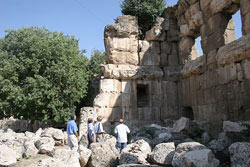
| Media are free to use and reproduce UNESCOPRESS outputs |
| UNESCO
UNESCOPRESS
7, Place de Fontenoy
75352 PARIS 07 SP, France
|
|
 
|
|  Nurturing the democratic debate.
Nurturing the democratic debate. | |
| UNESCO sends experts to carry out technical assessment of the effects of the war on Lebanon’s cultural heritage |
|
Editorial Contact: |
Isabelle Le Fournis, Press Relations Section, tel. +33 (0)1 45 68 17 48 - Email |
|
Audiovisual Contact: |
Ariane Bailey, Photo Unit, tel. +33 (0)1 45 68 16 86 - Email |
08-09-2006 4:45 pm The Director-General of UNESCO, Koďchiro Matsuura, today announced that the Organization will send a mission of experts, from September 10 to 16, to assess the potential damage caused to cultural sites in the recent conflict in Lebanon. The mission will, among other things, visit UNESCO’s World Heritage sites of Tyre, Baalbek and Byblos. Tyre and Baalbek, first built by the Phoenicians grew over the centuries and retain, to this day, some of the finest examples of Imperial Roman architecture at its zenith. The experts will analyze the structural soundness of the monuments on these sites and their state of conservation. The mission will, among other things, visit UNESCO’s World Heritage sites of Tyre, Baalbek and Byblos. Tyre and Baalbek, first built by the Phoenicians grew over the centuries and retain, to this day, some of the finest examples of Imperial Roman architecture at its zenith. The experts will analyze the structural soundness of the monuments on these sites and their state of conservation.
Byblos, north of Beirut, bears testimony to the earliest stages of the Phoenician civilization and early urban organization in the Mediterranean world. It has been affected by the oil spill caused by a leak from a coastal power plant bombarded in July. The experts will assess the potential damage of the oil spill to the ancient Port.
The experts are also expected to visit cultural heritage sites in the south of Lebanon that are not inscribed on the World Heritage List, as has been requested by the Lebanese authorities.
UNESCO first sent a mission to Lebanon in August for a preliminary identification of possible areas of cooperation with the national authorities.
“While initial inspection has revealed no significant destruction of cultural heritage sites in Lebanon, we must ensure,” the Director-General explained, “that ancient edifices have not been structurally weakened by the impact of explosions nearby.
“The safeguarding of Lebanon’s heritage is important both because of its outstanding universal value and because of the role it plays in the nation’s awareness of its identity as a multi-cultural society that has lived and prospered in harmony over millennia,” Mr Matsuura added.
“Naturally,” he said, “UNESCO also stands ready to help Israel take stock of the effect of the war on its heritage, including, for example, the Old City of Acre inscribed on UNESCO’s World Heritage List.”
UNESCO’s mission to Lebanon will be headed by Mounir Bouchenaki - the Director-General of the International Centre for the Study of the Preservation and restoration of Cultural Property (ICCROM), an advisory organization to the World Heritage Committee. He will be accompanied by two experts from the International Council on Monuments and Sites (ICOMOS), also an advisory body to Committee. These experts specialize respectively in the structural analysis of monuments and in the preservation of stone.
The head of the UNESCO World Heritage Centre’s Desk for the Arab Region will also be part of the mission, along with a UNESCO photographer and cameraman who will take still and moving images of the heritage sites visited.*
The findings of the mission will be presented at a press conference at UNESCO Headquarters at 11 am on 18 September.
*Photographic and video material produced by UNESCO will be available from 18 September.
|
|
Source |
Press Release N°2006-111
|
|
Author(s) |
UNESCOPRESS
|
|
|
|
|
|
|
|
|
|
|
|
 |
|



